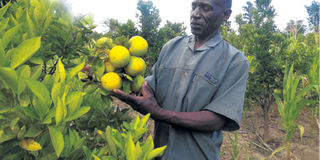With oranges, I have conquered arid soil

Wilson Kebenei at his orchard in Bomet County, which is semi-arid. To orchard keepers, peaking may also refer to that time when trees reach the height of fruition. PHOTO | ANDREW MIBEI
What you need to know:
- In a good season, which lasts about four months, a single tree produces an average of 400 fruits that retail at Sh10 each, earning the farmer at least Sh4,000 a year.
- He has a further 400 trees that will start producing fruits in a year’s time. The farmer is currently working as a trainer with Soin Integrated Development Project, an NGO, to sensitise farmers in the semi-arid region on the importance of fruit farming and why they should get involved.
Wilson Kebenei does not remember the last time he worried about the rains failing.
“It has been years, not one or two but more than a decade,” says the 57-year-old who lives in Bomet East constituency.
Poor rains are the norm in the semi-arid region. Most farmers who plant maize and beans among other crops do not get much as the rains fail most of the time. The maize necrotic disease has added pain to farmers’ plight.
But Kebenei beat all this by farming oranges. The fruits do well in the semi-arid region.
On his farm, he has 200 mature trees with fruits at different stages of growth. “I planted my first 100 grafted seedlings in 1990 that matured in two years.
Since then, I have never looked back,” says the farmer, who owns over two acres.
The farmer increased the number of trees gradually.
“I planted the fast maturing varieties, which grew fast and motivated me to plant more.”
In a good season, which lasts about four months, a single tree produces an average of 400 fruits that retail at Sh10 each, earning the farmer at least Sh4,000 a year.
Kebenei has learnt the art of grafting and has since been producing his own seedlings that he plants and also sells.
“Most of the seedlings I graft are bought by farmers from neighbouring counties.” To graft a seedling, Kebenei starts by developing the root stock from lemon seedlings that he grows from seeds.
After a year, he grafts a scion from a good orange tree on the lemon, ties the two tightly using polythene strips and after 21 days, the scion becomes attached to the root stock.
He then cuts off the lemon shoot and allows the grafted bud to grow. Three months after the bud is attached to the root stock, it is ready for planting on the farm.
The farmer plants two varieties of oranges namely Washington Navel and Valencia Late that do well in low altitude regions.
The former produces huge but few fruits per tree while the latter produces many medium-sized oranges. Kebenei says Valencia Late does well in the market because of affordability.
He inter-crops his oranges with legumes and vegetables, particularly, during the rainy season. The legumes help to keep the orchard free of weeds while supplementing his income.
In the over 20 years that Kebenei has been planting oranges, he has not encountered any challenge marketing his produce.
“I normally harvest at least two 90kg bags of fresh fruits and take them to Bomet Town where I sell all of them.” This year, Kebenei expects to harvest fruits that will earn him up to Sh800,000.
He has a further 400 trees that will start producing fruits in a year’s time. The farmer is currently working as a trainer with Soin Integrated Development Project, an NGO, to sensitise farmers in the semi-arid region on the importance of fruit farming and why they should get involved.
“Fruit farming is good and earns better than maize or beans, but the problem are the poor roads. He also has to content with thieves, who at times invade his farm.




